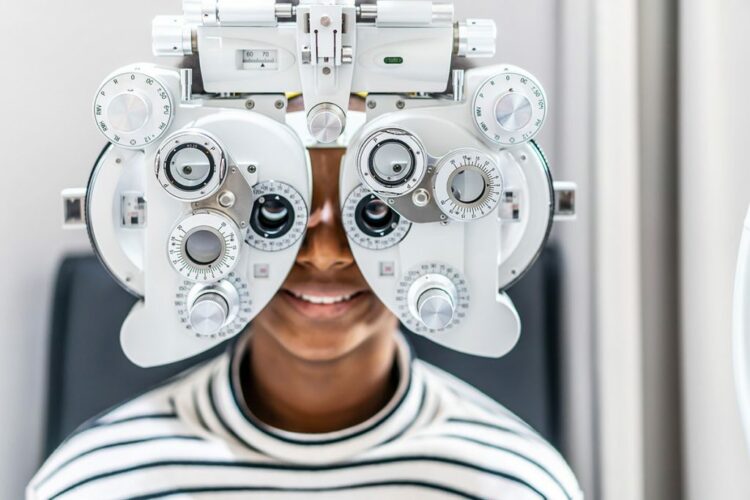Posted by: Clemson Eye in Eye Health, Technology

As we move through 2024, advancements in technology and shifts in healthcare priorities are bringing about significant changes in eye exams. Keeping up with these trends can help you ensure the best care for your vision. Here’s a look at the latest trends in eye exams this year.
1. Increased Use of AI and Machine Learning
Artificial Intelligence (AI) and machine learning are transforming eye exams by enhancing diagnostic accuracy and efficiency. AI-powered tools are now capable of analysing images of the retina, cornea, and other eye structures with exceptional precision. These tools can help detect conditions like diabetic retinopathy, age-related macular degeneration (AMD), and glaucoma earlier than ever before, allowing for timely intervention.
2. Integration of Telemedicine
Telemedicine has become more prominent in eye care, allowing patients to consult with eye care professionals remotely. Virtual eye exams are now possible, where patients can undergo preliminary assessments through digital platforms. This trend is especially beneficial for those who live in remote areas or have mobility issues. While not a complete substitute for in-person exams, telemedicine can help identify issues that require further investigation.
3. Enhanced Digital Eye Strain Management
With the rise of digital devices, digital eye strain has become a common issue. Eye care professionals are now focusing more on managing digital eye strain through specialized exams and treatments. New tools and techniques, including blue light filtering lenses and digital ergonomics assessments, are being used to alleviate symptoms such as dryness, discomfort, and blurred vision associated with prolonged screen time.
4. Personalized Eye Care
Personalization in eye care is on the rise, with tailored eye exams that consider individual lifestyle and genetic factors. Advanced diagnostic tools are now capable of assessing how personal habits and genetic predispositions affect eye health. This information allows eye care providers to offer customized recommendations for prevention and treatment, leading to more effective and personalized care.
5. Emphasis on Preventative Care
Preventative care is gaining more emphasis in eye exams. Regular check-ups are encouraged to monitor eye health and catch potential issues early. Eye care professionals are focusing on educating patients about lifestyle choices, such as diet and UV protection, that can impact long-term eye health. Preventative strategies also include screenings for early signs of conditions that might not yet have symptoms.
6. Advancements in Contact Lens Technology
The field of contact lenses continues to evolve with advancements in technology. New types of contact lenses, including those with built-in sensors and drug-delivery systems, are being developed. These innovations can help monitor eye health and even release medications directly into the eye, improving both convenience and treatment efficacy.
FAQ
1. What is AI’s role in eye exams?
AI assists in analysing diagnostic images and data, improving the accuracy of detecting eye conditions such as glaucoma, AMD, and diabetic retinopathy. AI tools can process vast amounts of data quickly, aiding eye care professionals in making more accurate diagnoses.
2. Can telemedicine replace in-person eye exams?
While telemedicine is a valuable tool for preliminary assessments and consultations, it cannot entirely replace in-person eye exams. Certain conditions and detailed evaluations require direct examination by an eye care professional.
3. What is digital eye strain and how can it be managed?
Digital eye strain results from prolonged exposure to screens and can cause symptoms such as dryness, discomfort, and blurred vision. It can be managed with strategies like taking regular breaks, using blue light filtering lenses, and optimizing screen settings. Eye exams can help assess the severity and recommend appropriate treatments.
4. How are eye exams becoming more personalized?
Eye exams are becoming more personalized by incorporating information about a patient’s lifestyle, genetic factors, and individual health history. This approach allows for tailored recommendations and treatments that are specific to each patient’s needs.
5. What are the latest advancements in contact lenses?
Recent advancements in contact lenses include smart lenses with built-in sensors for monitoring eye health and lenses that can release medications directly into the eye. These innovations aim to enhance comfort, convenience, and treatment effectiveness.
Conclusion
Staying informed about these trends can help you make better decisions about your eye care. Whether it’s incorporating the latest technology into your exams or focusing on personalized care, 2024 is a year of exciting developments in the field of optometry. Don’t hesitate to schedule your next eye exam and take advantage of these advancements to protect your vision for the future.